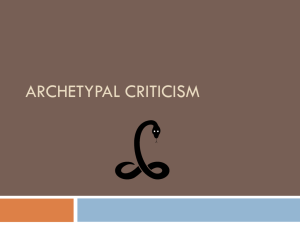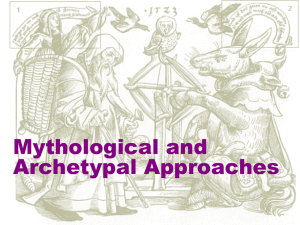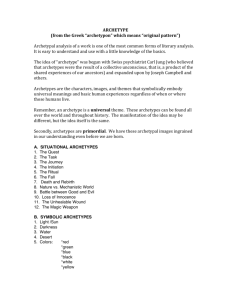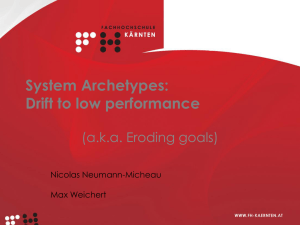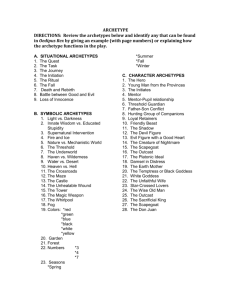Chapter 7: Mythological Approaches
advertisement
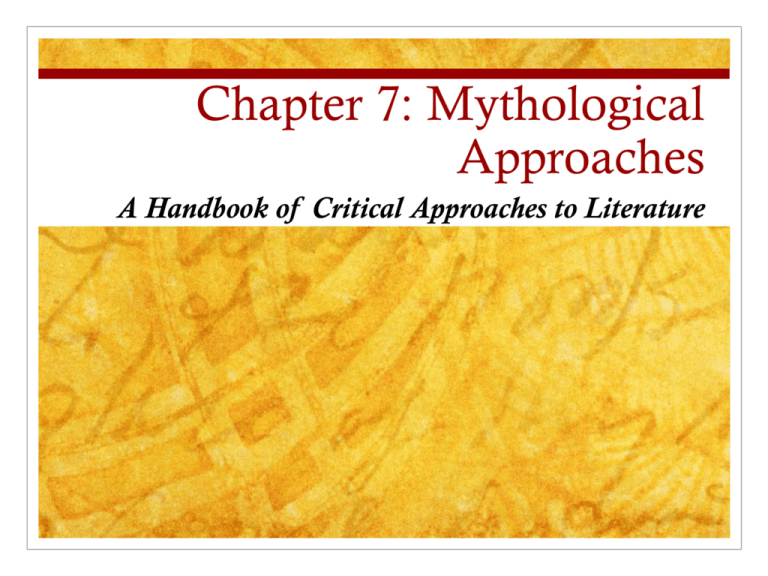
Chapter 7: Mythological Approaches A Handbook of Critical Approaches to Literature I. Definitions and Misconceptions Myth criticism deals with what Joseph Campbell called a “very deep chord” shared by all humans; the myth critic seeks out those mysterious elements that inform literary works and elicit near-universal human reactions, though there is no completely universal symbol. Why do certain works become classics? Archetypes Connections with psychological approaches and Literary Darwinism Myth not a fiction, not just Greek and Roman mythology or children’s fables II. Some Examples of Archetypes A. Images Water, sun, colors, circle, serpent, numbers, archetypal woman (Good Mother, Terrible Mother, anima or soul-mate), demon lover, wise old man, trickster, garden, tree, desert, mountain B. Archetypal Motifs or Patterns Creation, immortality, hero/heroine (quest, initiation, scapegoat) II. Some Examples of Archetypes C. Archetypes as Genres Northrop Frye, genres as seasons: spring/comedy summer/romance autumn/tragedy winter/irony III. Myth Criticism in Practice A. Anthropology and Its Uses Cambridge Hellenists, Sir James Frazer’s The Golden Bough and archetype of sacrificed king/scapegoat; Sophocles’s Oedipus Rex as example 1. The Sacrificial Hero: Hamlet Gilbert Murray and Frances Fergusson read Hamlet as the story of a natural rhythm of the kingdom disturbed by sin so that Hamlet must avenge and restore order in atonement/catharsis 2. Archetypes of Time and Immortality: “To His Coy Mistress” Poem about time—its conclusion offers an escape from historical into cyclical time and hence immortality III. Myth Criticism in Practice B. Jungian Psychology and Its Archetypal Insights Life and career of Carl Gustav Jung; theory of the collective unconscious and archetypes; connections between dreams and myths 1. Some Special Archetypes: Shadow, Persona, and Anima 2. “Young Goodman Brown”: A Failure of Individuation Brown is unable to reconcile his shadow, persona, and anima—cannot individuate III. Myth Criticism in Practice in 3. Creator or Creator: Who is the Real Monster Frankenstein? Victor suffers a failure of individuation in that his selfishness divides him from everyone, but also from nature Jung: “It is often tragic to see how blatantly a man bungles his own life and the lives of others yet remains totally incapable of seeing how much the whole tragedy originates in himself, and how he continually feeds it and keeps it going.” 4. Syntheses of Jung and Anthropology James Baird’s archetypal reading of Moby-Dick III. Myth Criticism in Practice C. Myth Criticism and the American Dream: Huckleberry Finn as the American Adam Definition of the American Adam; myths of New World as Eden George Baxter Adams (germ theory); Frederick Jackson Turner (frontier theory) Mythic elements of quest, water symbolism, shadow, trickster, wise old man, archetypal woman, initiation D. “Everyday Use”: The Great [Grand]Mother


